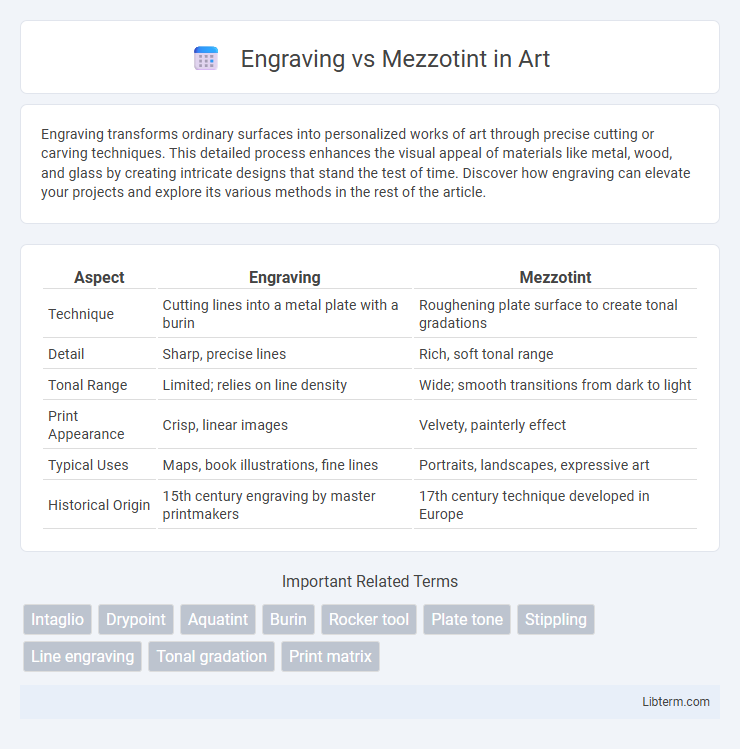Engraving transforms ordinary surfaces into personalized works of art through precise cutting or carving techniques. This detailed process enhances the visual appeal of materials like metal, wood, and glass by creating intricate designs that stand the test of time. Discover how engraving can elevate your projects and explore its various methods in the rest of the article.
Table of Comparison
| Aspect | Engraving | Mezzotint |
|---|---|---|
| Technique | Cutting lines into a metal plate with a burin | Roughening plate surface to create tonal gradations |
| Detail | Sharp, precise lines | Rich, soft tonal range |
| Tonal Range | Limited; relies on line density | Wide; smooth transitions from dark to light |
| Print Appearance | Crisp, linear images | Velvety, painterly effect |
| Typical Uses | Maps, book illustrations, fine lines | Portraits, landscapes, expressive art |
| Historical Origin | 15th century engraving by master printmakers | 17th century technique developed in Europe |
Understanding Engraving: Definition and Techniques
Engraving involves incising intricate designs onto a hard surface, traditionally metal plates, using tools like burins to create precise lines and textures. Techniques include line engraving, where varying line depth and spacing control shading, and cross-hatching for added detail. Mastery of engraving requires steady hand control and an understanding of material resistance to achieve the desired visual effects.
What is Mezzotint? Process and Methods
Mezzotint is a printmaking technique developed in the 17th century that produces rich tonal variations by roughening a metal plate with a rocker to create a textured surface capable of holding ink. The artist smooths areas of the plate to create lighter tones, allowing for detailed gradations from dark to light in the final print. Unlike engraving, which uses incised lines for images, mezzotint relies on manipulating texture and tone for softer, more painterly effects ideal for reproducing subtle shading and atmospheric depth.
Historical Origins: Engraving vs Mezzotint
Engraving originated in the 15th century as a printmaking technique where artists incise lines onto metal plates, widely used by masters like Albrecht Durer during the Renaissance. Mezzotint emerged later in the 17th century, developed by Ludwig von Siegen, introducing a method to create rich tonal contrasts through roughening and smoothing metal surfaces. Both techniques reflect significant advancements in art reproduction, with engraving emphasizing line detail and mezzotint excelling in tonal gradation.
Key Differences in Materials and Tools
Engraving relies on hardened steel or copper plates and uses sharp burins or gravers to cut precise lines into the surface, resulting in fine, crisp details. Mezzotint employs a rocker tool to roughen the entire metal plate, typically copper, creating a textured surface that allows for smooth tonal gradations through selective smoothing. The fundamental difference lies in engraving's line-based technique versus mezzotint's tonal method, each requiring distinct tools and material preparations to achieve their characteristic visual effects.
Visual Characteristics and Artistic Effects
Engraving produces sharply defined lines with precise detail and high contrast, resulting in crisp, clear images often used for intricate designs and fine textures. Mezzotint creates rich tonal gradations through a textured, velvety surface effect, enabling smooth transitions between light and dark and offering a more painterly, atmospheric quality. The engraving's linear clarity contrasts with mezzotint's subtle shading, making each technique suited for distinct artistic expressions and visual impact.
Popular Uses and Applications in Art
Engraving is widely used for detailed line work in printmaking, book illustrations, and official documents due to its precision and durability. Mezzotint is favored for producing rich tonal gradients and deep contrasts, making it popular in portraiture and fine art prints that require subtle shading. Both techniques continue to influence contemporary art, with engraving excelling in graphic clarity and mezzotint offering a painterly texture.
Durability and Reproduction Quality
Engraving offers exceptional durability due to its deep incised lines on metal plates, allowing for numerous high-quality reproductions without significant wear. Mezzotint, characterized by its textured tonal variations, produces rich, velvety images but sees faster plate degradation, limiting the number of precise reproductions. The sharpness and line clarity in engraving generally surpass mezzotint's softer gradations, making engraving preferable for sustained reproduction quality.
Pros and Cons: Engraving vs Mezzotint
Engraving offers precise, detailed lines ideal for fine artwork and printmaking, providing excellent durability for multiple reproductions but can be time-consuming and requires skill to avoid mistakes. Mezzotint excels in creating rich tonal gradients and deep shadows, making it perfect for expressive, textured images, though it is labor-intensive and less suited for sharp line work. While engraving is favored for intricate designs and mass production, mezzotint is preferred for tonal depth and artistic effect, each technique balancing complexity, detail, and visual style.
Famous Artists and Masterpieces
Engraving, exemplified by Albrecht Durer's intricate works like "Melencolia I," showcases precise line work and detail, while Mezzotint, mastered by artists such as Rembrandt with masterpieces like "Christ Healing the Sick," excels in rich tonal gradients and deep contrasts. Engraving techniques emphasize sharp lines carved into metal plates, producing crisp images favored during the Renaissance, whereas Mezzotint uses a textured surface to create smooth transitions between light and shadow, enhancing dramatic effect. Both methods significantly influenced printmaking history, with Durer and Rembrandt standing as iconic figures who elevated their respective styles to artistic heights.
Choosing the Right Technique for Your Project
Engraving offers precise, clean lines ideal for detailed designs and fine text, making it perfect for formal invitations or intricate logos. Mezzotint creates rich tonal gradients and deep shadows, suited for artistic prints and images requiring smooth, painterly effects. Assess project goals by considering the desired texture and detail level to choose between the sharp clarity of engraving and the soft tonal quality of mezzotint.
Engraving Infographic

 libterm.com
libterm.com